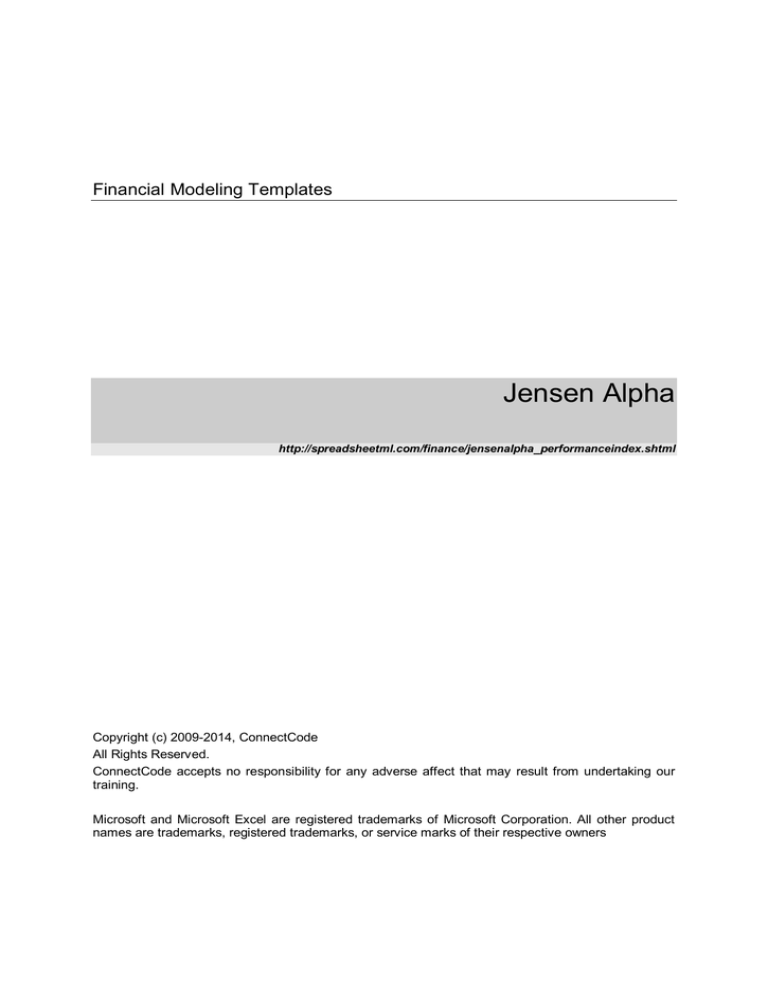
Financial Modeling Templates
Jensen Alpha
http://spreadsheetml.com/finance/jensenalpha_performanceindex.shtml
Copyright (c) 2009-2014, ConnectCode
All Rights Reserved.
ConnectCode accepts no responsibility for any adverse affect that may result from undertaking our
training.
Microsoft and Microsoft Excel are registered trademarks of Microsoft Corporation. All other product
names are trademarks, registered trademarks, or service marks of their respective owners
Table of Contents
1.
Jensen’s Alpha................................................................................................................. 1-1
1.1
Jensen’s Alpha ...................................................................................................... 1-1
1.2
Jensen's Alpha Spreadsheet ................................................................................. 1-1
1.2.1 Output....................................................................................................... 1-2
Pg ii
Jensen Alpha
Version 1.0
ConnectCode’s Financial Modeling Templates
Have you thought about how many times you use or reuse your financial models? Everyday, day
after day, model after model and project after project. We definitely have. That is why we build all
our financial templates to be reusable, customizable and easy to understand. We also test our
templates with different scenarios vigorously, so that you know you can be assured of their
accuracy and quality and that you can save significant amount of time by reusing them. We have
also provided comprehensive documentation on the templates so that you do not need to guess or
figure out how we implemented the models.
All our template models are only in black and white color. We believe this is how a professional
financial template should look like and also that this is the easiest way for you to understand and
use the templates. All the input fields are marked with the ‘*’ symbol for you to identify them
easily.
Whether you are a financial analyst, investment banker or accounting personnel. Or whether you
are a student aspiring to join the finance world or an entrepreneur needing to understand finance,
we hope that you will find this package useful as we have spent our best effort and a lot of time in
developing them.
ConnectCode
Pg iii
Jensen Alpha
Version 1.0
1.
1.1
Jensen’s Alpha
Jensen’s Alpha
Jensen's Alpha is also known as the Jensen's Performance Index. It was first used in the 1970s by
Michael Jensen to evaluate the performance of fund managers. Specifically, it is measuring the
difference between the actual returns of a portfolio during a period and the expected returns of the
portfolio using the Capital Asset Pricing Model (CAPM). The formula for Jensen's Alpha is as shown
below:
Jensen's alpha = Portfolio Return–(Risk Free Rate+Portfolio Beta*(Market Return-Risk Free Rate))
This performance index is now widely used by the public for measuring the performance of investment
or fund manager. The formula can be thought of as calculating the excess returns a fund manager
has made over the broader market. An example of a broader market is the S&P 500 composite. A
positive value indicates good securities picking skills of a fund manager. If you are comparing the
Jensen's Alpha of similar portfolios by different fund managers, then the bigger the Jensen's Alpha
indicates a better performance of the fund.
1.2
Jensen's Alpha Spreadsheet
This spreadsheet provides a basic template for calculating the Jensen's Alpha. It uses monthly data of
the portfolio and the broader market over a period of 1 year for the calculation. This can be easily
expanded to 3-5 years period commonly seen in investment reports.
Pg 1-1
Jensen Alpha
Version 1.0
1.2.1
Output
The Variance of the Portfolio and the Market is first calculated followed by the Covariance of the
Portfolio with respect to the broader market. The S&P 500 composite data can be used in calculating
the Jensen's Alpha of a U.S portfolio. The Variance and Covariance are then used in the calculation
of the Portfolio's Beta. This Beta is used for calculating the Expected Return of the Portfolio using
CAPM.
The calculation of the monthly Risk Free rate is as shown below.
Monthly Risk Free Rate = ((1+Annual Risk Free Rate)^(1/12)-1)
Pg 1-2
Jensen Alpha
Version 1.0





